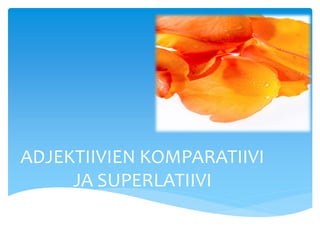Comparative and Superlative
- 1. ADJEKTIIVIEN KOMPARATIIVI JA SUPERLATIIVI
- 2. S├ä├äNT├¢J├ä: ’Ƭ 1-tavuisten adjektiivien komparatiivi muodostetaan yleens├ż lis├ż├żm├żll├ż -er ja superlatiivi lis├ż├żm├żll├ż -est, esim..: Perusmuo Komparatiivi Superlatiivi to Soft Softer The softest Cheap Cheaper The cheapest Sweet Sweeter The sweetest Thin Thinner The thinnest
- 3. Oikeinkirjoitus: ’Ƭ Jos 1-tavuinen adjektiivi loppuu yksitt├żiseen vokaaliin + yksitt├żiseen konsonanttiin, konsonantti kahdentuu, esim.: thin ŌåÆ thinner, big ŌåÆ biggest. ’Ƭ Jos adjektiivi loppuu e :hen, e katoaa ennen ŌĆōer/-est ŌĆō p├ż├żtett├ż, esim.: wide ŌåÆ wider/widest. ’Ƭ Jos adjektiivi p├ż├żttyy konsonantti + y, y korvataan i:ll├ż p├ż├żtett├ż ŌĆōer/-est lis├żtt├żesss├ż, esim.: dry ŌåÆ drier/driest.
- 4. 2-tavuiset adjektiivit ’Ƭ 2-tavuiset ŌĆōy ŌĆōloppuiset adjektiivit muodostavat komparatiivin lis├ż├żm├żll├ż -er ŌĆōp├ż├żtteen ja superlatiivit lis├ż├żm├żll├ż ŌĆōest ŌĆōp├ż├żtteen ’Ƭ Huom! y -> ie Perusmuoto Komparatiivi Superlatiivi Lucky Luckier The luckiest Pretty Prettier The prettiest Tidy Tidier The tidiest
- 5. Muut 2-tavuiset ’Ƭ 2-tavuiset adjektiivit, jotka p├ż├żttyv├żt -ed, - ing, -ful, or -less muodostavat komparatiivin more- ja superlatiivin the most -sanoilla, esim.: Perusmuoto Komparatiivi Superlatiivi Worried More worried The most worried Boring More boring The most boring Careful More careful The most careful Useless More useless The most useless
- 6. 3-tavuiset ’Ƭ Adjektiivit, joissa on kolme tai useampia tavuja, muodostavat komparatiivin ja superlatiivin sanoilla MORE ja THE MOST, esim.: Adjektiivin perusmuoto Komparatiivi Superlatiivi Dangerous More dangerous The most dangerous Difficult More difficult The most difficult Huom! Adjektiivit, joissa on UN-etuliite: unhappy ŌĆō unhappier ŌĆō the unhappiest/ the most unhappy
- 7. EPÄSÄÄNNÛLLISET ADJEKTIIVIT Adjektiivi Komparatiivi Superlatiivi Good Better The best Bad Worse The worst Far Farther/further The farthest/furthest
- 8. Komparatiivien k├żytt├Č ’Ƭ Komparatiivimuotoa seuraa usein than ja pronomini /pronomini /substantiivi, jota verrataan aiempaan pronominiin/substantiiviin: ’Ƭ John is taller than me. ’Ƭ I think that sheŌĆÖs more intelligent than her sister.
- 9. Viel├ż komparatiivin k├żyt├Čst├ż: ’Ƭ Komparatiivien yhteydess├ż k├żytet├ż├żn usein ilmauksia: as much, a lot, far, a bit/little, slightly etc., esim.: You should go by train, it would be much cheaper. Could you be a bit quieter? IŌĆÖm feeling a lot better. Do you have one thatŌĆÖs slightly smaller? ’Ƭ Kaksi komparatiivia saadaan kontrastiin lis├ż├żm├żll├ż the ennen komparatiivia, esim.: The smaller the gift, the easier it is to send. The more stressed you are, the worse it is for your health. ’Ƭ Toistamalla komparatiivia voit osoittaa ominaisuuden ŌĆślis├ż├żntymist├żŌĆÖ, e.g.: ’Ƭ The sea was getting rougher and rougher. ’Ƭ Her illness was becoming worse and worse. ’Ƭ He became more and more tired as the days went by
- 10. Superlatiivin k├żytt├Č ’Ƭ Superlatiivimuodot voivat, komparatiivien tavoin, sijoittua substantiivin eteen (attribuuttina). Ne voivat esiinty├ż my├Čs BE-verbin j├żljess├ż. Esim. ’Ƭ the most delicious fruit cake IŌĆÖve ever eaten ’Ƭ Lisa was the youngest ’Ƭ This hotel is the best ’Ƭ Superlatiiveja k├żytet├ż├żn usein yksin├ż├żn (ks. kaksi viimeist├ż esimerkki├ż yll├ż), jos on selv├ż├ż, mit├ż tai ket├ż vertaillaan. ’Ƭ Jos haluat tarkemmin m├ż├żritell├ż, mit├ż olet vertailemassa, voit tehd├ż sen substantiivilla tai prepositorakenteella (in / of): ’Ƭ Lisa was the youngest child ’Ƭ Lisa was the youngest of the children ’Ƭ This hotel is the best in town.
- 11. KOMPARATIIVI- JA SUPERLATIIVIMUOTOJEN VASTAKOHTIA ’Ƭ K├żyt├żmme muotoja less (more-komparatiivin vastakohtana), ja the least (superlatiivin the most vastakohtana). Less = ŌĆśv├żhemm├żnŌĆÖ, ŌĆśei niinŌĆÖ ’Ƭ This sofa is less comfortable. ’Ƭ IŌĆÖve always been less patient than my sister. The least = ŌĆśv├żhitenŌĆÖ ’Ƭ ItŌĆÖs the least expensive way to travel. ’Ƭ She was the least intelligent of the three sisters. Ritva Tammi 2011



























































